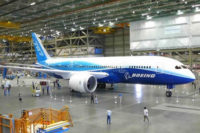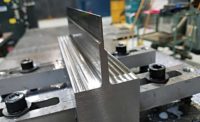Automating aircraft assembly processes is one of the biggest challenges facing aerospace manufacturers today. Earlier this year, Boeing partnered with the Department of Mechanical Engineering at the University of Washington to tackle the issue.
The new Boeing Advanced Research Center (BARC) is developing a variety of aircraft and spacecraft production tools and processes. The 4,300-square-foot facility is housed in the mechanical engineering building on the “UDub” campus in Seattle.
“Faculty, graduate students and undergraduate students are collaborating with Boeing engineers on a daily basis, and we are working on real problems,” says Per Reinhall, a professor of mechanical engineering and BARC director. “Currently, there are five full-time Boeing engineers and five part-time engineers. All Boeing engineers have been appointed UW affiliate instructors.
“Having Boeing engineers here in the same physical space working with students and faculty is very exciting,” explains Reinhall. “We get to have some of the most significant airplane manufacturing and design issues come through this lab. It supports an exciting new trend in education where students learn by doing, along with close interaction with industry.”
The BARC is the brainchild of Jim Buttrick, a Boeing engineer who serves as the center’s associate director. He received his master’s degree in mechanical engineering from UDub three decades ago. Buttrick saw a good opportunity for students to gain practical experience and Boeing to benefit from more researchers on projects.
“We strategically chose projects where we want to solve a problem, but we see there are areas where we can employ academic talent to work on portions of a project and come up with viable solutions,” says Buttrick. “It will give us a fresh perspective and enhance our ability to innovate.”
Under the initial two-year contract, Boeing will invest $800,000 annually to fund four projects that focus on automation, robotics and aircraft assembly. According to Reinhall, the plan is to seek more funding to continue the center indefinitely and bring in more projects.
“The lab is designed to be a flexible space that will adapt to each project,” says Reinhall. “We currently are working on flexible automation, so we have a number of robotic devices and sensors.” Actual airplane parts, as well as smaller replicas, will be housed in the lab as the projects develop.
“Compared to the auto industry, which is highly automated, the scale or size of aircraft, the precision required, and the quantity of parts make aerospace automation a challenge,” Reinhall points out. Other hurdles include tight tolerances and low production volumes.
The initial focus of the BARC is on automation, robotics, mechatronics and metrology applications for structural aircraft assembly. Projects include predictive shimming and sensor fusion. Other projects are focusing on ways to automate the riveting of fuselages and predicting the final, full-sized shape of aircraft structures.
“Confined space automation is one of our key projects,” says Reinhall. “We are developing tools and machines that [assemblers] can operate remotely so they don’t have to physically enter confined spaces.”
One BARC project is designed to make it easier for assemblers to build the insides of airplane wings and other confined spaces where it is physically hard to work. Engineers are examining how little robots or remotely operated vehicles could be programmed to go inside these small spaces and place nuts on bolts, seal seams and inspect the inside of a wing to make sure foreign objects and debris is removed.







